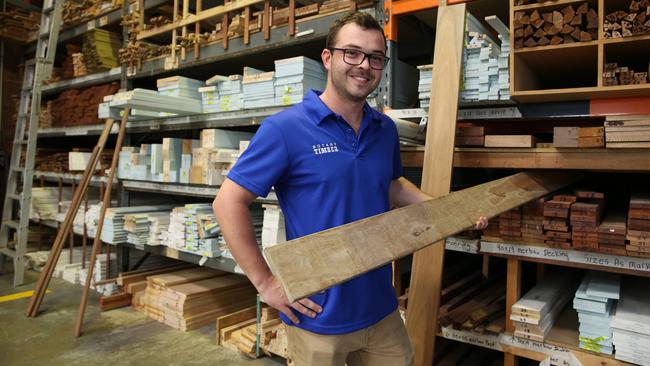Bushfires take toll on timber supplies
The devastating bushfires are expected to put even more of a squeeze on timber supplies for the building industry.

Devastating bushfires are expected to put even more of a squeeze on timber supplies, with the construction industry ramping up earlier warnings of a supply shortage in the lead-up to summer.
Early assessments of NSW forestry reserves have estimated about 50,000ha of plantations have been burnt by bushfires across the state — almost one-fifth of NSW forestry assets — particularly around Tooma and Tumbarumba in the southwest of the state.
For Alastair Kelly, the head of sales at Botany Timber, in Sydney’s south, a shortage was going to be a matter of time.
“A lot of the hardwood timber we source — like spotted gum and blackbutt — comes from areas that have been impacted by bushfires,” said Mr Kelly, whose company supplies hardware timber across Sydney. “Those hardwoods are the most popular decking timber — we’ll definitely feel the shortage at some point.”
Although some of the damaged timber will be salvageable in the short term, Master Builders Australia chief executive Denita Wawn said her association raised concerns about a timber supply shortage before the bushfires began, and that the issue was raised again at a bushfire recovery roundtable last month.
Ms Wawn said she felt the supply shortage would predominantly be felt by local building and timber supply companies, which could affect the housing construction market.
“What we’ve found is that you find that larger businesses will purchase long-term bulk orders, which as a consequence makes it harder for smaller operators and regional operators to access timber quickly,” Ms Wawn said.
“We need to ensure that we have sufficient products to meet demand over the next 12 months, so when we get to a spike in rebuilding activities in the coming months we have minimised any supply shortages.”
Her comments came as official figures released this week showed building approvals rose for the first time in 18 months. Building approvals climbed 2.7 per cent in the year to December, after a 2.8 per cent fall in the year to November, according to Australian Bureau of Statistics figures.
While assessments are ongoing across NSW, the age profile of timber plantations and the severity of the damage will determine the extent of the issue for suppliers.
“While it was too early to tell the full extent of the damage, it would be naive to think this isn’t going to have an impact on the supply chain,” said Housing Industry Association chief executive Kristin Brookfield.
Ric Sinclair, managing director of Forest and Wood Products Australia, said with bushfires also hitting large swathes of Victoria’s traditional forestry fields in the state’s east, the medium-term impact on the nation’s timber supply would not be known for a couple of months.
“The critical thing is that we haven’t finished this fire season,” Mr Sinclair said.
A potential saving grace for timber suppliers is the ability to preserve timber products for up to five years under sprinklers or irrigation dams. Mr Sinclair said forestry suppliers were now racing to determine how much of their products could be stored.
“Short term I would expect to see more wood in the market. In the medium term, you would expect to see imports fill the gap — they currently fill 20 per cent of the market,” he said.
In a statement, ForestCorp, which manages NSW’s largest plantation estate, said detailed assessments were ongoing, but preliminary reports indicated 50,000ha of timber plantations had been affected.
“Much of the timber from the softwood plantation areas may still be salvageable as pine trees can be harvested for 12 months or more after a fire. Logs can be stored for longer if immersed in water or under sprinklers,” the statement said.
“We will be working closely with industry to process timber from the affected plantations and replant the areas to regrow our future timber supply.”



To join the conversation, please log in. Don't have an account? Register
Join the conversation, you are commenting as Logout